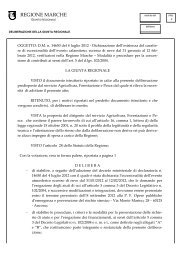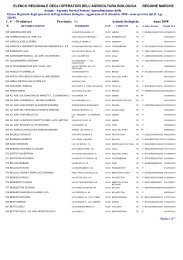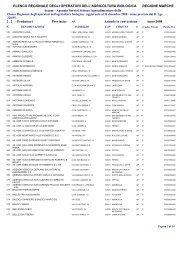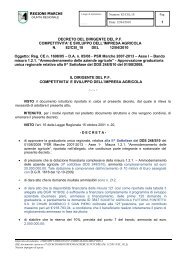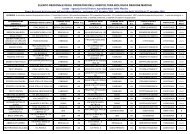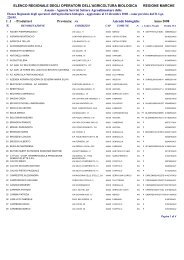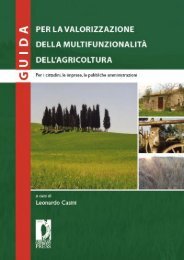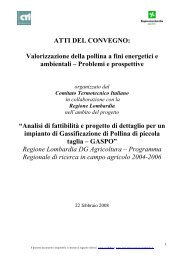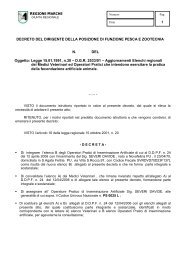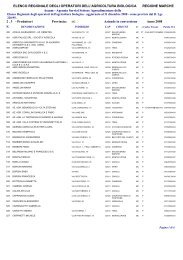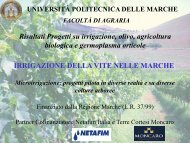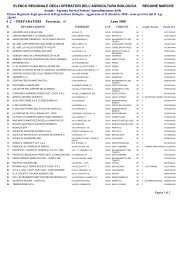The Marchigiana Cattle Breed
The Marchigiana Cattle Breed
The Marchigiana Cattle Breed
You also want an ePaper? Increase the reach of your titles
YUMPU automatically turns print PDFs into web optimized ePapers that Google loves.
<strong>The</strong> <strong>Marchigiana</strong>:<br />
a breed to be exported<br />
Adriatic New<br />
Neighbourhood Programme<br />
Interreg IIIA Adriatic Crossborder<br />
Marcbal<br />
Project
Marcbal Project<br />
<strong>The</strong> development of know-how networks between the two sides of<br />
the Adriatic for the modernization of the primary productive structure<br />
and the innovation of the provided services and technology is an<br />
innovative challenge given the existent differences in the real and<br />
perceived quality production in the two areas and bearing in mind<br />
the difficulties arising due to the existent differences in the economic,<br />
administrative and juridical systems of the Italian Adriatic Region<br />
(IAR) and the Eastern Adriatic Countries (EAC). Promoting the<br />
sustainable development of the rural development, the strengthening<br />
of the public and private assistance structure and the primary<br />
sector services are the premises on which the<br />
Marcbal project is based, promoted by the<br />
PF Pesca e Zootechnia of the Marche Region<br />
within the Adriatic New Neighbourhood Programme<br />
INTERREG/CARDS/ PHARE.<br />
With the involvement of public and private<br />
bodies, the project aims at reinforcing the<br />
services promoting new techniques in company<br />
management, new products and/or<br />
productive technologies and new cultural<br />
methods in the companies operating in the<br />
agriculture sector, by improving the quality<br />
systems in the cattle meat sector. With the<br />
exchange of know-how between the partners<br />
of the two sides of the Adriatic, the project<br />
aims at contributing towards the formation<br />
of an administrative system in quality zoo-<br />
technology of the <strong>Marchigiana</strong> cattle breed<br />
in the Eastern Balkans (registry, genetic,<br />
research and veterinary) by the spreading of<br />
the good practices of the <strong>Marchigiana</strong> cattle<br />
breeding and the methods to improve the<br />
zootechnological agricultural productions.<br />
<strong>The</strong> project strategies include surveying,<br />
data analysis and, eventually, the exchange<br />
of know-how related to the defined survey<br />
areas:<br />
- Herbaceous cultivations, techniques and<br />
productions of sustainable breeding<br />
- Reproduction methodologies and techniques<br />
- Food and veterinary safety<br />
- Administrative managements and services<br />
to enterprises<br />
<strong>The</strong> project involves six Italian partners from<br />
three Adriatic Regions (Marche, Abruzzo and<br />
Friuli Venezia Giulia) and two partners from<br />
the Eastern Balkans (Albania and Bosnia<br />
Herzegovina) forming a multidisciplinary<br />
partnership that includes public entities<br />
and advanced education structures of the<br />
sector at issue.
<strong>The</strong> <strong>Marchigiana</strong> <strong>Cattle</strong> <strong>Breed</strong>:<br />
historical outline<br />
<strong>The</strong> bos taurus asiaticus, ancestor of the <strong>Marchigiana</strong> breed, first<br />
appeared on the Italian peninsula, together with men and armies,<br />
migrated from the ancient Podolia, an extended region between<br />
Galizia and Ukraine, at the time of the renowned Lombard leader<br />
Agilulfo during the barbarian invasions of the VI century.<br />
This cattle characterised by a big neck, long and pointed horns,<br />
a grey or yellowish cast, black eyelids, switch of tail, horns and<br />
nails, indigenous to the Asiatic steppe, can be considered the<br />
ancestor of today’s <strong>Marchigiana</strong> breed, which is indeed called<br />
the breed of the Podolica stock.<br />
However, the real history of the <strong>Marchigiana</strong> breed starts in1800,<br />
intertwined with complex historical-economic events of its native<br />
area, the Marche, dominated by the “farm agreement” known as<br />
métayage.<br />
Before 1800, the Podolica cattle became the workforce used for<br />
the tillage of lands and cultivation. It was the ploughing ox rented<br />
by the owner of the grounds to the farmer.<br />
In the early XIX century the number of<br />
cattle on the farm increased and it began<br />
to be thought of as a necessary investment.<br />
However, the production of meat was given<br />
very little importance and it was limited to<br />
“boiling meat”.<br />
In fact, the Podolica cattle had a very slow<br />
body development and was poor meat<br />
producer due to scarce fattening possibilities.<br />
<strong>The</strong> change from the double use of<br />
the breed for work-meat, to the specificity<br />
of the breed as meat producer proceeds<br />
hand in hand with the economic and social<br />
changes of the region. In order to improve<br />
the attitude towards meat production, at the<br />
end of 1800 the local cattle was crossbred<br />
first with Valdichiana bulls and, later, with the<br />
improver Romagnola bulls. This selection<br />
produced cattle with strong dynamic capacities<br />
and with a good attitude towards meat<br />
production, from which the significantly<br />
polymorphic “population breed” derived.<br />
In 1900, when the economic conditions of<br />
the working class improved, there was an<br />
increase in demand for meat and a growing<br />
awareness about the problem of specialization<br />
(meat or work) of the local cattle that in<br />
1928 amounted to 374,324 animals.<br />
With the Congress of Fermo in 1928, decisions<br />
were taken to suspend the introduction<br />
of the Chianina and the Romagnola<br />
bulls to proceed with the “morpho-functional<br />
genotype” selection, in order to obtain cattle<br />
with its own particular features, characterized<br />
by a “unity of blood and type”. <strong>The</strong>refore,<br />
in 1931 the Herd Book was set up<br />
to specify the organisational aspect of the<br />
selection which allowed the production of<br />
rustic animals, resistant and characterised<br />
by a quick growth.<br />
On 14th July 1959, the Provincial <strong>Breed</strong>ers<br />
Association of Ancona, Ascoli and Macerata<br />
approved the statute that articulates<br />
the constitution of A.N.A.B.R.M (National<br />
Association of the <strong>Marchigiana</strong> <strong>Cattle</strong> <strong>Breed</strong><br />
<strong>Breed</strong>ers). <strong>The</strong>refore, the <strong>Marchigiana</strong> is<br />
known as “the bovine cattle breed with<br />
the best qualities to be applied even in the<br />
areas that are most significantly marked,<br />
in negative terms, with our environmental<br />
conditions.”<br />
<strong>The</strong> ANABIC, the national association which<br />
aims at selecting, improving, planning and<br />
valorising Italian meat breeds abroad, was<br />
set up in 1966.
<strong>The</strong> <strong>Marchigiana</strong> in the World<br />
<strong>The</strong> breed is now bred in the Marche, in Abruzzo, Molise, Basilicata,<br />
Lazio, Sicilia and Campania: in Italy, more than 46,000<br />
are registered in the Herd Book.<br />
In 1956 the <strong>Marchigiana</strong> was introduced for the first time in Brazil.<br />
However, a more consistent exportation of animals to European<br />
and Non-communitarian Countries has taken place only as<br />
from the ‘70s that has gained favour with breeders due to its great<br />
productive adaptability and performance.<br />
As from 1998 the meat of the <strong>Marchigiana</strong> cattle breed, between<br />
12 and 24 months, is among the P.G.I. quality brand “White Bullock<br />
of the Central Apennines”, regulated by specific production<br />
measures.
Genetic improvement and selection:<br />
objectives and tools<br />
<strong>The</strong> selection of the <strong>Marchigiana</strong> cattle breed aims at:<br />
• <strong>The</strong> production of animals with a marked ability to produce<br />
meat, in terms of growth speed, precocity and slaughtering<br />
and skinning outcome, safeguarding its capacity to adapt to<br />
the breeding systems;<br />
• <strong>The</strong> improvement of maternal abilities and the reproductive<br />
efficiency features such as the first delivery and the interval<br />
between deliveries in order to obtain the highest number of<br />
calves per cow a year.<br />
<strong>The</strong> universally selected method adopted is the performance<br />
test which measures the features of the characteristics for<br />
which the animals to be indexed are selected.<br />
<strong>The</strong> performance tests for the <strong>Marchigiana</strong> breed are submitted<br />
by the Genetic Centre of the A.N.A.B.I.C on animals purposely<br />
selected from the population. Once submitted to serological tests,<br />
the animals then enter a quarantine and an adaptation phase at the<br />
end of which there is a 24 week test. During this period the calves<br />
are placed in a performance shed, which<br />
will host them until the age of one, during<br />
which various inspections and zoometric<br />
surveying are carried out.<br />
<strong>The</strong> collected data is then analysed with<br />
the BLUP Animal model with which the<br />
two indices, Growth and Muscularity, are<br />
obtained to form the Bull Selection Index<br />
that expresses the bull’s capacity to produce<br />
muscular tissue and to provide high<br />
meat outcomes. Only the best 30% of the<br />
tested bulls are assigned to Artificial Insemination<br />
subject to quali-quanititative<br />
checking of seminal material. <strong>The</strong> Genetic<br />
Index of Morphology of the factoring-cow<br />
was introduced in 2001, derived from the<br />
morphological data regarding muscularity,<br />
size, thinness and limbs of the heifers.<br />
<strong>The</strong> best male reproducers are used, according<br />
to programmed breeding plans, for<br />
the best cows with high genetic index.<br />
<strong>The</strong> calves born from this breeding will<br />
have the priority to enter the Genetic Centre<br />
for a new Performance test cycle (source<br />
ANABIC).<br />
<strong>The</strong> Herd Book<br />
• is a selection tool which aims for genetic preservation and<br />
improvement of meat breeds;<br />
• gathers, in databases, sets of personal, genealogical, morphological,<br />
productive and reproductive data of the cattle being<br />
chosen;<br />
• is regulated by specific disciplinary measures approved by the<br />
ministry of agricultural policies.
Evolution and selection<br />
Presently, the adult bovine can reach a<br />
weight of 12-15 quintals, the female can<br />
reach 7-9 quintals.<br />
<strong>The</strong> coat is white, shades of grey in the<br />
front part of the body may also be seen;<br />
black pigmentation that varies in intensity<br />
can be also seen on the skin, mucosae oris<br />
and natural apertures. <strong>The</strong> skin is fine in<br />
quality, easy to lift and soft, features that<br />
benefit commercial value of the animal for<br />
slaughter and perform a thermoregulatory<br />
function. <strong>The</strong> head is light with a straight<br />
profile and a flat, light and expressive foreheads;<br />
the eyes are lively and alert.<br />
<strong>The</strong> back is long, broad and with marked<br />
muscle development, demonstrating a<br />
“double convexity” due to the longissimus<br />
dorsi which supplies cuts rich in muscle<br />
tissue. Thigh and buttocks present an accentuated<br />
development of muscle mass<br />
that are important in producing noble cuts<br />
of beef.<br />
<strong>The</strong> slaughtering outcome is about 63%<br />
reaching up to 67%.<br />
<strong>The</strong> average daily growth can reach 2 kg.<br />
In the last ten years the <strong>Marchigiana</strong> breed<br />
has shown an increase of 100g/day in<br />
ADG both in the performance and the<br />
pre-performance.<br />
<strong>The</strong> muscularity increased from 355 to 387<br />
points with an average increase of 3 units<br />
per year.<br />
<strong>The</strong> weight at 356 days has an immediate<br />
increase of about 40 kg, exceeding the<br />
550 kg.<br />
10 11
<strong>Breed</strong>ing: six good reasons to choose it<br />
<strong>The</strong> breeding of the <strong>Marchigiana</strong> breed, in the near future, may<br />
become a strength for the traditional breeding areas as well as<br />
the new ones since they have certain advantages:<br />
• the genetic type is strongly suitable for difficult environmental<br />
conditions;<br />
• high self-management capacities without the fundamental<br />
interventions of the breeders;<br />
• low-cost environment friendly operator, a very useful figure mainly<br />
in those areas of naturalistic and/or landscape interests;<br />
• germoplasma reserve of considerable value;<br />
• production of food with very high qualitative value;<br />
• source for entrepreneurial activity opportunities in “marginal”<br />
areas, for the product processing and marketing.<br />
In fact: rusticity, precocity, harmony in shape and adaptability<br />
are the features that allow this breed to be subjugated to the<br />
breeding and the semi-breeding system maintaining very good<br />
productive and reproductive performance. <strong>The</strong>refore, the breeding<br />
of the <strong>Marchigiana</strong> must be considered as<br />
a valid opportunity for meat production and<br />
for crossbreeding, in territorial areas that<br />
can be defined as “marginal”.<br />
As regards reproductive efficiency, in the<br />
semi-breeding typology, the breed shows<br />
a decrease in the interval between the deliveries<br />
and an improvement in the capacity<br />
to wean.<br />
<br />
In this breeding system it is necessary to<br />
prepare health inspection programmes for<br />
the herd, use selected breeders and carry<br />
out functional inspections.<br />
<strong>The</strong> cow-calf line is a tool for the valorisation<br />
of zootechnology in the mountain areas<br />
to minimize herd management costs in order<br />
to obtain a weaned calf per cow per year,<br />
to produce good quality calves in terms of<br />
weight, structure and health state.<br />
<strong>Breed</strong>ing according to the cow-calf line<br />
allows the exploitation of cultivated and natural<br />
grazing resources creating financial<br />
advantages in terms of herd feeding costs<br />
which will be linked to the necessity to integrate<br />
any nutritional deficit in the ration eaten<br />
away when grazing. Grazing can only fully<br />
accomplish its multiple productive, environmental,<br />
landscape and protective functions<br />
if technically well managed. Only rational<br />
grazing plans can ensure the good feeding<br />
of the animals (samples and quality), the<br />
maintenance or the improvement of forage<br />
quality, its completeness, the high vegetal<br />
and animal biodiversity and the preservation<br />
of an open and exploitable space.<br />
12 13
Meat production and quality<br />
<strong>The</strong> <strong>Marchigiana</strong> cattle breed reaches the ideal weight at 15-16<br />
months, with outcomes up to 67% given the thinness of the skeletal<br />
structure and the skin which gives a better slaughtering outcome.<br />
<strong>The</strong> <strong>Marchigiana</strong> beef reaches the optimal intramuscular fat rate<br />
for the slaughtering when he is 18-24 months old.<br />
Meat and health<br />
In recent years, the consumer’s attention towards safer and healthier<br />
feeding has generated an increase in quality meat consumption<br />
and a consistent revaluation of the rustic breeds which, being<br />
more suitable for grazing, have meat with a certain qualitative<br />
importance. <strong>The</strong> <strong>Marchigiana</strong> breed is part of those native breeds<br />
with high prestige which, in the light of their versatility, may have a<br />
more extensive breeding system and productions with interesting<br />
organoleptic features, appreciated both in Italy and abroad.<br />
<strong>The</strong> quality of bovine meat is effected by exogenous (feeding,<br />
environment, post-slaughtering interventions) and biological<br />
(age at slaughtering, localization and anatomic functionality of<br />
the muscle, sex and genetic type) factors.<br />
<strong>The</strong>refore, the qualitative merits of these<br />
meats are first and foremost linked to the<br />
place and a long selection activity which<br />
lasts years and also the semi-grazing breeding<br />
system and the type of feeding which<br />
mainly consists of wild vegetable essences<br />
which give a unique flavour to the meat.<br />
Quality certification<br />
From 1998 the meat of the <strong>Marchigiana</strong><br />
breed became one of the first quality<br />
brands for fresh bovine meats approved<br />
by the European Community for Italy: the<br />
P.G.I. (Protected Geografic Identification)<br />
“White Bullock of the Central Apennines”.<br />
<strong>The</strong> reference laws were initially the EEC<br />
regulations n.2081/92 and 2082/92 which<br />
establish the production measures in order<br />
to guarantee maximum quality and food<br />
safety for the consumer. In recent years<br />
the Communitarian legislative framework<br />
was very little adaptable to the changes that<br />
took place in Europe and globally, which<br />
led to the necessity to replace regulations<br />
no. 2081/92 and 2082/92 with EC Reg.<br />
no.509/2006 and 510/2006.<br />
Besides providing rigid indications about<br />
breeding, the measures define the entire<br />
productive process at every phase.<br />
Nutritional quality<br />
Bovine meat has low lipid content (more<br />
unsaturated fats than saturate ones) and<br />
an important sources of proteins, minerals<br />
(especially Zinc and Iron) and group B<br />
vitamins.<br />
Studies carried out at the University of Teramo<br />
have shown that 100 g of meat from<br />
the P.G.I Bullock of the Central Apennines<br />
provides 50% of Zinc and 16% of Iron of<br />
the daily requisites of an adult man (Table<br />
1, page 16).<br />
14 15
(Table 1: Contents of 100 g of PGI bovine meat)<br />
% Average Values Regulatory Measures RDA needs of 100 g of meat<br />
Woman<br />
Man<br />
Water 75,4 n.p 36% 42%<br />
Proteins 22,9 >20<br />
Lipids 1,9
Four seasons with the <strong>Marchigiana</strong><br />
a recipe for every season<br />
<strong>The</strong> Fiorentina...<br />
always<br />
Autumn<br />
Roast beef with Pore Mushrooms<br />
1 kg of flank in one whole piece<br />
extra virgin olive oil<br />
2 cloves of garlic smashed<br />
600 g of pore mushrooms<br />
in thick slices<br />
a spoonful of chopped parsley<br />
salt, pepper<br />
a glass of white wine<br />
4 spoonfuls of grated Parmesan<br />
Preparation<br />
Tie the meat and seal it with very hot oil. Heat some oil and the garlic in a low<br />
saucepan, add the mushrooms, cook for 5 minutes, add pepper and salt, add the<br />
parsley and remove the garlic.<br />
Transfer the meat, draining it from the sealing fat, to the saucepan with the mushrooms<br />
and cook for 5 minutes.<br />
Isolate the meat from the cooking base by putting a grid on the bottom of the<br />
saucepan. Cover and let it rest for at least 10 minutes. Untie the meat, cut slices<br />
of about 1cm and a half thick, place it on a hot tray and cover every slice with<br />
mushrooms, serve the slices of roast beef sprinkled with grated Parmesan and<br />
sprinkle with the filtered cooking base.<br />
Winter<br />
Beef with walnuts<br />
1 kg of flatiron steak of beef<br />
extra virgin olive oil<br />
a ladle of soup<br />
1 small chopped onion<br />
50 g breadcrumbs<br />
half lemon juice<br />
1 garlic clove<br />
20 walnuts<br />
1 glass of marsala<br />
Preparation<br />
Prepare the meat for cooking, tie it and seal it in a<br />
small saucepan with some oil and then soak it with<br />
one ladle of soup.<br />
Stir the onion, add the breadcrumbs which have been<br />
previously mixed with the lemon juice and squeezed,<br />
salt, pepper and garlic. Soak the mixture with marasala,<br />
mix and pour it on the meat.<br />
Add the soup, cook on a low flame for about 2 hours.<br />
Serve sliced.<br />
Spring<br />
Stew with artichokes<br />
1 kg of sottofesa<br />
dry white wine<br />
10 cleaned artichokes<br />
chopped in quarters<br />
2 onions<br />
2 celery leaves<br />
2 garlic cloves<br />
parsley, oil, salt and<br />
pepper<br />
Preparation<br />
Marinate the meat in the wine with half of the artichokes,<br />
the onions, the celery and the garlic for about 8 hours.<br />
Trickle the meat, dry it, tie it, seal it carefully with hot<br />
oil, add salt, mix the marinade with the vegetables and<br />
cook on a low flame for about 3 hours.<br />
Whisk the marinade, adjust it with salt and place it on a<br />
flame to reduce it. In the meantime cook the remaining<br />
artichokes in oil and parsley.<br />
Serve the meat on a hot plate, surrounded by the artichokes<br />
and sprinkled with the sauce.<br />
Summer<br />
Cold rump in green sauce<br />
800 g rump of tender beef<br />
1 l of water<br />
1 l of vinegar<br />
Sauce<br />
100 g parsley leaves<br />
25 g capers<br />
half fresh small onion<br />
extra virgin olive oil, salt and pepper<br />
Preparation<br />
Marinated the rump for 4 hours in equal parts of water<br />
and vinegar, remove the meat, bring the water and<br />
vinegar to boil and put the tender beef in it for an hour,<br />
let the meat cool in the cooking liquid.<br />
For the sauce: whisk all the ingredients. Serve the<br />
sliced meat with the sauce after savouring the dish<br />
for about 1 hour.<br />
Beefsteak with fillet or the sirloin and the T-bone taken<br />
from the sirloin of the White Bullock of the Central<br />
Apennines of 16 to 24 months of age, the Fiorentina is<br />
a true “ritual” of the Italian cuisine. Its thickness varies<br />
from 6 to 8 cm, its weight from 900g to 2kg.<br />
Preparation<br />
It is necessary to have an ardent grill, without flame,<br />
the steak needs 6 minutes of cooking on every side<br />
and 15 minutes to rest vertically on the bone which<br />
acts as a heat conductor to keep it warm and to ensure<br />
appropriate cooking.<br />
18<br />
19
Marche Region<br />
PF Pesca e Zootecnia<br />
Lead Partner of Marcbal Project<br />
Via Tiziano, 44<br />
60125 Ancona<br />
tel +39 071 8063738<br />
fax +39 071 8063055<br />
www.regione.marche.it<br />
funzione.PescaZootecnia@regione.marche.it<br />
Polytechnic University of Marche<br />
Faculty of Agriculture<br />
Department of Environmental<br />
and Crop Science<br />
Ministry of Agriculture, Food and<br />
Consumer Protection<br />
Tirana, Albania<br />
Euromediterranea<br />
Social Promotion Association<br />
University of Agriculture<br />
Tirana, Albania<br />
Abruzzo Region<br />
University of Sarajevo<br />
Faculty of Agriculture<br />
Bosnia and Herzegovina<br />
University of Teramo<br />
Department of<br />
Food Sciences<br />
University of Udine<br />
Department of<br />
Animal Sciences<br />
capolinea.it<br />
Sviluppo Marche SpA-Società Unipersonale<br />
Territory and Rural Development Area<br />
Via Martiri delle Resistenza, 24<br />
60125 Ancona<br />
tel +39 071 289941<br />
fax +39 071 28994235<br />
www.svimspa.it<br />
rdpolicies@svimspa.it<br />
<strong>The</strong> initiative has been realized with the financial support of the European Regional Development Fund in the<br />
framework of Adriatic New Neighbourhood Programme Interreg IIIA Adriatic Crossborder.<br />
Special Thanks to:<br />
ANABIC<br />
APA in Marche Region<br />
ARA in Abruzzo Region<br />
Consorzio Produttori<br />
Carne Bovina Pregiata delle Razze Italiane<br />
Azienda Agraria Biologica “Arca Felice”<br />
Bibliography and sources:<br />
ANABIC-“<strong>The</strong> <strong>Marchigiana</strong> breed”, 2000<br />
ANABIC- “4th World Italian Beef <strong>Cattle</strong> Congress”,<br />
29th April-1st May 2005<br />
“I Quaderni della Carne” Consorzio di Tutela “Vitellone<br />
Bianco dell’Appennino Centrale” in collaboration with<br />
“Scuola di Cucina di Susanna Baldi”



